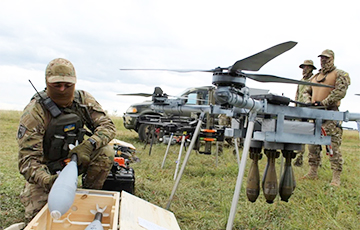Forbes: AFU Prepare Offensive By 50,000 Drones
23- 27.03.2023, 9:35
- 33,984

The situation on the frontline can change dramatically.
The American magazine Forbes notes that Russian online media is buzzing with fear of an imminent attack by tens of thousands of Unmanned Aerial Vehicles (UAVs) on Russian troops invading Ukraine, indicating that Kyiv is allegedly preparing to change the situation on the frontline radically.
Oleksiy Arestovich spoke about the upcoming drone attack in January. He was a freelance adviser to the Office of the President of Ukraine Volodymyr Zelensky until recently. And in February, the Ukrainian General Staff announced the creation of the "world's first UAV strike company".
According to the Russian Engineer Telegram channel, Ukraine bought up almost the entire market of relatively cheap FPV racing drones equipped with video cameras in China, “according to indirect estimates, 50-100 thousand units”.
These drones are smaller than standard quadcopters but are equipped with powerful engines that allow the lightweight drone to reach speeds of up to 200 km/h.
It is enough to attach a grenade to it - and the drone can be used as a radio-controlled kamikaze drone, which is able to quite accurately hit targets at a relatively large distance from the operator controlling it via video link.
Ukrainian forces carried out this tactic of improvised FPV drone attack in July, with the quadcopter diving through an open doorway into a building occupied by Russian troops before exploding.
Since then, such attacks have proliferated, according to the article. There are online videos of improvised radio-controlled kamikaze strikes at Russian tanks (the device can easily dive into an open hatch) or at trenches of Russian units that cannot be reached by direct fire from the ground.
According to Forbes, at least half of the sorties by these drones are successful. They hit the intended target despite the fact that "they are cheap and easily available compared to other guided weapons and loitering ammunition".
The publication cites calculations according to which the creation of each such handcraft kamikaze costs only a few hundred dollars, which is much cheaper than even an ordinary high-quality quadcopter, not to mention the Iranian Shaheds when Moscow pays from 20,000 to 50,000 dollars for each, according to some estimates.
Russian Engineer pounders that a raid of 50,000 drones could become an attack of unprecedented scale. Considering that racing drones are very resistant to radio interference, it will not be possible to stop them with ordinary radio jamming.
Waves of flying kamikazes can come in one after another, striking Russian positions "until all targets are destroyed." Moscow accused Ukraine of the drone explosion near Tula the day before. The explosion left a crater with a diameter of about 8 meters.










